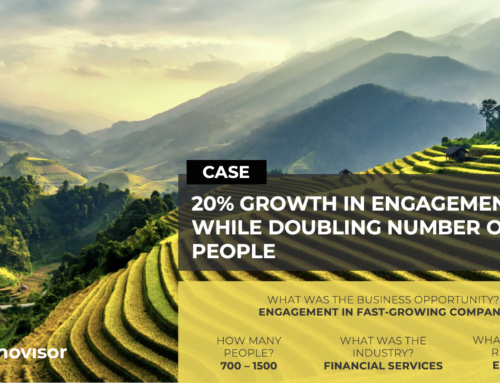
How A Company Moved From Being a Start-Up to a Scale-Up
To succeed in scaling up your company, you need to navigate through specific danger zones. One of these danger zones is when your company has around 125 to 175 people. Jeppe Vilstrup Hansgaard mentions that this is the size, “where fragmentation has set in and groups cluster together informally and develop their own identities”. It is therefore critical to understand how people are connected so that an organization can grow without becoming inefficient due to the danger zones it moves through.
A fintech company grew to 200 employees in four locations in only four years’ time. This company obviously went through the danger zones of every scale up – but in this case with an astonishing speed! Management realized they missed out on the key insights into how people really were connected in the organization and how they were aligned with the company’s direction, so that they could continue scaling up their company.
Innovisor was asked to run a culture diagnostic – known as the Start-Up Kit. This resulted in a baseline that showed the company how to navigate safely through the danger zones for a knowledge intensive organization. One of the areas the management wanted us to look at was how decision making was structured in the company that moved from being a start-up to a scale up.
KEY INSIGHT: CENTRALIZED DECISION MAKING!
Decision-making was indeed a challenge for the company. People went to management for making decision. Knowing that these members of the management were only within two locations, this created challenges for a company in a rapid growth mode.

This setup in which management were central in the decision-making made sense at a time the company was a start-up. It is however problematic when the company is a scale up. The members of management – 8% of the total workforce – were bottlenecks that slowed down the decision-making process and with that the agility of the company.
Around 40% of all people were in the locations without any member of the management team. These locations also had limited connections for decision making. What if decisions needed to be made on behalf of the locations that didn’t have any management team members around? This headquarter vs non-headquarter syndrome is problematic – especially in such a fast-growing company. This ‘syndrome’ can backfire. One of the first danger signals is whether people feel informed about the direction of the company.
CONCLUSION
The company needed to make changes to how decisions were made in the company. It needed to move away from a centralized decision-making process to a decentralized decision-making process. This way it could continue to grow at the same pace while making sure everybody is onboard. Two years after this diagnostic, the company grew to more than 800 people in nine locations – and there are no signs the scaling up stops!
Do you also need the right insights into how people are connected so that you can scale up?





